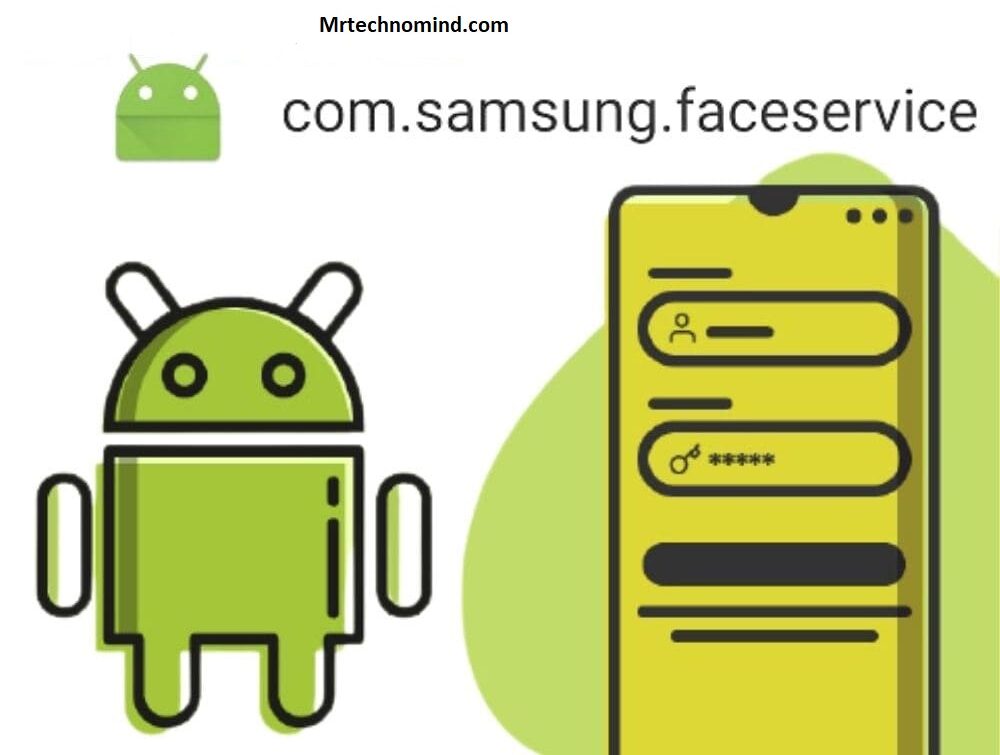Com.samsung.faceservice What Is It and How To Fix It?

You’re probably familiar with Android, the world’s most popular operating system for smartphones and tablets. You may even be a Samsung devotee, impressed by their innovative products that blend design and technology seamlessly. But have you ever delved deeper into your device’s operations? If so, you might have stumbled upon com.samsung.faceservice. Don’t worry if this sounds like tech-jargon; we’re here to demystify it.
Com.samsung.faceservice is one of those background services running on your Samsung device that you may not be aware of until it starts acting up or draining your battery life. It plays a crucial role in facial recognition technologies used by Samsung devices, ensuring smooth functioning of features such as face unlock and other applications that require face detection functionalities. However, like any other software component, it can sometimes cause issues or become a subject of security discussions. In this article, we’ll explore what com.samsung.faceservice is all about, its importance, how it works and how you can manage it effectively on your device.
Understanding Android Operating System

Ever wondered what makes your Android phone tick? Let’s unravel the mysteries of this powerful operating system together! At its core, Android is a Linux-based operating system designed primarily for touch screen mobile devices such as smartphones and tablets. It was developed by a consortium of developers known as the Open Handset Alliance, with the primary contributor being Google. Its high degree of customization sets Android apart from other mobile operating systems. This means you can modify every aspect of your device’s software to suit your preferences.
When it comes to mobile interface design, Android is at the forefront. It provides an intuitive user interface that incorporates easy-to-understand icons, menus and settings, allowing you to navigate your device effortlessly. Ever noticed how each Samsung smartphone has a distinctive feel despite running on the same underlying Android platform? That’s because Samsung uses its own custom skin, One UI overlaying on top of Android, to provide users with unique features and aesthetics catered specifically for their products.
Understanding how these elements come together harmoniously allows us to appreciate just how dynamic and flexible the Android operating system truly is. The fusion between customizable software and innovative hardware designs creates a personalized user experience that defines why we love our android devices so much. Now that we’ve got some insight into what makes up our beloved android phones, it sets us up perfectly to delve deeper into specifics like understanding ‘com.samsung.faceservice’ which is integral to enhancing our interaction with these fantastic gadgets.
Defining Com.samsung.faceservice
You might be wondering what this specific term refers to – it’s essentially a system application developed by a renowned electronics brand for their smartphones, primarily focused on facial recognition features. The com.samsung. face service is integral to Samsung’s proprietary services, designed specifically for Samsung devices to enhance their functionality and user experience. As the name suggests, this service is chiefly linked with operating and managing the facial recognition technology embedded in these devices.
- It forms an essential device security component, enabling users to unlock their phones using biometric authentication.
- It assists in improving the device’s overall performance by effectively managing its resources.
- It simplifies user interaction with the device through advanced facial recognition features.
Com.samsung.faceservice uses sophisticated algorithms and techniques to process image data captured from the front camera of your Samsung smartphone. This software interacts directly with your phone’s hardware components, allowing it to accurately identify unique facial features and compare them against stored data for authentication purposes. The precision and accuracy involved in this process make it an effective tool against potential security threats.
The remarkable aspect about com.samsung.faceservice is that it operates silently in the background without causing any significant drain on system resources or affecting overall device performance. Understanding how this service functions can help you appreciate the depth of technological innovation that goes into making our everyday smartphone experiences smooth and secure. Let’s delve deeper into understanding precisely how com.samsung.faceservice works under-the-hood to provide such efficient functionality.
How Com.samsung.faceservice Works

Curious about how this facial recognition tech operates behind the scenes? Let’s dive right in! The com.samsung.faceservice is a system application responsible for managing all facial recognition tasks on Samsung devices. It is one of the many Samsung Innovations that revolutionized smartphone security and accessibility. When you activate your device’s facial recognition function, it triggers com.samsung.faceservice to start scanning and analyzing your face using your gadget’s front camera.
Here’s a simplified breakdown of how it works:
| Step | Description |
|---|---|
| 1 | You initiate facial recognition setup in your phone settings. |
| 2 | The front camera scans your face, capturing its unique features like the shape, size and position of eyes, nose, cheeks and mouth. |
| 3 | These details are then stored securely within the device as a detailed biometric map used for future identification. |
It’s important to note that while com.samsung.faceservice performs an essential function for Facial Recognition Technology, it also plays a critical role in other applications that utilize user face data on Samsung devices. For instance, various Augmented Reality (AR) apps such as filters or emojis use this service to accurately overlay digital content onto users’ faces captured by the camera.
It is comprehending how com.samsung.faceservice functions gives you an appreciation for the advanced technology at work every time you unlock your device using just your face. But why does this matter? Well, understanding its importance can help you appreciate its convenience and the level of security it provides. Let us delve deeper into why com.samsung.faceservice is pivotal in modern smartphone usage next.
Importance of Com.samsung.faceservice
Recognizing the significance of this facial recognition tech can truly change how we perceive our smartphone usage. The com.samsung.faceservice is vital to the Facial Recognition Evolution that has taken place in recent years, positioning Samsung at the forefront of biometric technology advancements. Its incorporation into various devices enables a seamless and secure user experience that highlights Samsung’s Technological Innovations.
The importance of com.Samsung.faceservice is multi-fold:
- Enhanced User Experience: By leveraging facial recognition technology, users can unlock their devices swiftly and efficiently, without remembering complex passwords or patterns.
- Safety: Com.samsung.faceservice offers enhanced security by ensuring that only the registered user’s face can unlock the device, providing additional protection against unauthorized access.
- Technological Advancement: As part of Samsung’s broader commitment to investing in state-of-the-art technologies, com.samsung.faceservice represents a crucial step towards creating more intelligent and intuitive consumer devices worldwide.
It’s worth noting that while such technological developments offer countless conveniences, they also bring about potential risks and concerns around privacy and data security. These features are designed with robust protocols to protect sensitive information from falling into wrong hands. Yet no system is foolproof; therefore understanding these implications becomes paramount as we continue to embrace this new era of digital identification methods — leading us seamlessly into our next discussion about the security implications surrounding facial recognition technologies used in smartphones today.
Security Implications

As we delve deeper into facial recognition technologies, it’s crucial to consider the security implications accompanying these advancements. Samsung’s ‘com.samsung.faceservice’ is a complex technology integral to their devices, yet its inherent nature raises several privacy concerns. For instance, by storing and processing facial data on your device, there’s a potential risk for this sensitive information being accessed improperly or even hacked. While Samsung does apply rigorous encryption methods and in-built safeguards, no system can be completely impervious to threats.
The issue of data breaches further exemplifies these concerns. In an era where cyber attacks are increasingly prevalent and sophisticated, any stored personal information becomes an attractive target for hackers. If such a breach were to occur within the ‘com.samsung.faceservice’, this could result in unauthorized access to your device or misuse of your facial recognition data. This prospect could have severe consequences. On top of this, as facial recognition technology becomes more ubiquitous with each passing day, questions surrounding consent and control over one’s own biometric data become increasingly pertinent.
Despite these valid concerns, strides are being made in improving the robustness and security measures surrounding such technologies – with companies like Samsung leading the charge towards safer practices. It’s important not just for users but also developers and manufacturers alike to promptly stay informed about potential vulnerabilities to address them as part of ongoing development activities. Let us now discuss how you may encounter issues with ‘com.samsung.faceservice’ and what can be done about them without going into steps directly.
Troubleshooting Com.samsung.faceservice Issues

Having discussed the security implications related to com.samsung.faceservice, it’s equally important to delve into the potential issues and troubleshooting strategies for this feature. If you’re a Samsung user relying heavily on facial recognition technology, you might encounter Face Recognition Errors or Service Interruptions that could disrupt your smooth smartphone experience. These complications can arise due to several factors such as software glitches, outdated system updates or misconfigured settings.
Here are some common challenges and their corresponding solutions in a table format:
| Issues | Causes | Solutions |
|---|---|---|
| Face Recognition Errors | Poor lighting conditions | Ensure good lighting |
| Outdated software | Update your device | |
| Damaged front camera | Visit an authorized service center | |
| Service Interruptions | Unstable internet connection | Check your network settings |
| Excessive apps running in memory | Close unnecessary apps |
To handle face recognition errors, ensure that you are in a well-lit environment when using this feature as poor lighting can affect its efficiency. Also, always keep your device updated with the latest software version available from Samsung because outdated versions may contain bugs affecting facial recognition performance. In severe cases where you suspect damage to your phone’s front camera, getting professional help at an authorized service center is advisable. On the other hand, if there are frequent service interruptions while using com.samsung.faceservice, check for a stable internet connection and close any excessive applications running in the background that may be hogging memory resources.
Remember that these solutions only address common problems; unique issues might require further investigation. It’s also worth noting how critical managing com.samsung.faceservice effectively is – not just for seamless functionality but also for ensuring optimal security and privacy of your data. As we move onto discussing ‘how to manage com.samsung.faceservice’, remember these troubleshooting tips since they will come handy before getting into deeper management techniques.
How to Manage com.samsung.faceservice

You’re probably wondering how to take control of this facial recognition feature on your Samsung device, right? Well, it’s not as complex as you might think. The com.samsung.faceservice is a system app that plays an integral role in the operation of Face Recognition Privacy features on your Samsung devices. Remember, it’s built into the system so you won’t find it in your typical apps list. To manage this service, go through your device’s settings until you reach the biometrics and security section where face recognition can be toggled on or off depending upon your preference.
Managing this service doesn’t only revolve around turning it on or off; there are additional aspects associated with its functionality that allow for Service Customization. You can improve face recognition by regularly updating your appearance in varied lighting conditions and angles which will help the system register better and provide more accurate results. This makes facial recognition more adaptable to changes like aging or cosmetic alterations, thus enhancing user experience while ensuring security.
Now that you’ve understood how to manage the com.samsung.faceservice, bear in mind that like any other application running constantly in background, this too has implications on overall device performance. Just remember: moderation is key when using intensive features such as facial recognition. Next up, let’s delve into understanding how exactly com.samsung.faceservice influences performance metrics of Samsung devices and ways to optimize it for smoother operations.
Impact of Com.samsung.faceservice on Device Performance
Imagine your sleek Samsung device slowing down, its battery draining faster than usual, and you’re left wondering why. This sudden change in performance could be due to the impact of com.samsung.faceservice on your device. Com.samsung.faceservice is a system package that comes pre-installed on Samsung phones. It’s used for managing facial recognition data for unlocking the phone or apps, but if it starts acting up, it can cause some noticeable performance issues.
- Your phone might start running slower as com.samsung.faceservice consumes more processing power.
- You may notice an unusual increase in battery drainage because this service continually runs in the background.
- The overall user experience might suffer due to frequent lagging or freezing of the device.
Now let’s dig deeper into these potential issues. An increased CPU usage caused by com.samsung.faceservice can significantly slow down other applications on your device. This delay isn’t just annoying; over time, it can also affect the longevity of your smartphone’s hardware components. On top of that, this service’s constant operation in the background leads to quicker battery drainage – something no one appreciates! Performance optimization becomes paramount as a proactive measure against such drawbacks.
As you navigate these technicalities associated with com.samsung.faceservice and its effects on your device’s performance, remember that knowledge is power. Understanding what each Android system package does and how they influence your mobile experience will help you maintain optimal conditions for your Samsung gadget. Prepare for our next discussion where we dive into staying informed about android system packages and updates – beneficial knowledge to keep your phone performing at its best without any hitches!
Staying Informed About Android System Packages and Updates
It’s essential to stay on top of Android system packages and updates; they’re not just about adding new features or fixing bugs, but ensuring your device remains snappy and efficient. The operating system is a vast ecosystem of interdependent components, with each package playing its role in the overall performance of your device. One such component on Samsung devices is the com.samsung.faceservice, a crucial part of facial recognition technology that allows for quick access to your phone while maintaining security. Package management is integral to this process, allowing for seamless integration and operation between various system services.
With the constant evolution of technology, you must keep your Samsung device up-to-date with the latest software updates. These updates often contain critical fixes for any potential vulnerabilities, enhancing existing features and introducing new ones. Update notifications are designed to keep you informed whenever these upgrades become available so you can download them at your earliest convenience. Installing these updates promptly is always beneficial as they significantly improve your device’s performance and secure personal data.
Being proactive about understanding what each Android system package does can help you make better decisions regarding which updates are necessary for improving functionality or performance on your Samsung gadget. Remember, every app or service running on your phone has its individual package file that forms part of the larger Android ecosystem. As such, managing these packages effectively ensures optimal efficiency and goes a long way in safeguarding against potential security threats – keeping you one step ahead in today’s digital age.
Frequently Asked Questions
1. What Versions of Android Os Support Com.samsung.faceservice?
In terms of Faceservice Integration and Android Compatibility, the com.samsung.faceservice is supported by several versions of the Android operating system. Specifically, it’s typically integrated on Samsung devices running Android OS versions ranging from KitKat (4.4) up to Pie (9.0). However, remember that its functionality might not be as robust on older versions compared to newer ones due to improvements and updates made over time. It’s also important to note that this service may not be available or functional if you’re using a non-Samsung device or custom ROMs due to proprietary restrictions and compatibility issues inherent in these scenarios.
2. Can I Use Com.samsung.faceservice on Non-samsung Android Devices?
Unfortunately, you cannot use com.samsung. face service on non-Samsung Android devices. This has led to some Faceservice integration issues and fueled the Samsung exclusivity debate among users and developers. It’s important to understand that com.samsung.faceservice is a proprietary software package developed by Samsung for their devices which ties into their facial recognition technology. It’s specifically optimized for Samsung hardware, making it incompatible with non-Samsung devices. Although this exclusivity might seem restrictive, it allows Samsung to ensure a seamless user experience by tailoring the service to their specific device capabilities and specifications.
3. Does Com.samsung.faceservice Work With Third-party Camera Applications?
The com.samsung.faceservice is primarily designed to work with Samsung’s camera applications to optimize facial recognition accuracy. Even though you might be tempted to use it with third-party camera applications, it may not deliver the same level of performance or accuracy. This is because Samsung has meticulously calibrated its face service algorithm for its own products. Furthermore, privacy concerns are another significant matter to consider when using third-party apps as they might not adhere to the strict data handling and privacy policies that Samsung abides by. Therefore, while technically possible, using com.samsung.faceservice with third-party camera apps may result in compromised functionality and potential privacy risks.
4. What Happens if Com.samsung.faceservice is Accidentally Uninstalled?
If by chance you’ve accidentally uninstalled com.samsung.faceservice, you may notice some impact on your device’s performance. This service plays a crucial role in managing and improving the facial recognition features of your Samsung device, thus its absence might cause those features to malfunction or not work at all. But don’t fret, there are faceservice restoration methods available for you to get it back up and running. You can either perform a factory reset (though this will also erase all your data), or try reinstalling the latest updates from Samsung which usually include the essential system apps like faceservice. Therefore, while unintentional uninstallation may temporarily affect functioning, restoring this service isn’t impossible.
5. Are There Any Alternatives to Com.samsung.faceservice for Facial Recognition on Android Devices?
There are several alternatives to com.samsung.faceservice for facial recognition on Android devices. If you’re concerned about Facial Recognition Privacy, open source alternatives like OpenCV or Google’s ML Kit Face Detection could be your ideal solution. OpenCV is a comprehensive library with multiple machine learning algorithms and image-processing techniques, enabling it to support facial recognition features. On the other hand, Google’s ML Kit offers robust face detection capabilities with the advantage of being easy to integrate into Android apps due to its Firebase compatibility. Both these options provide privacy-focused solutions as they process data locally on your device instead of transmitting it over the internet. Remember though, while these services can offer similar functionalities as com. Samsung. face service, their performance might vary based on lighting conditions and camera quality.
Conclusion
You’ve now got a good grasp of what com. Samsung. face service is all about. It’s an essential cog in the smooth running of your Samsung device, managing face recognition and other key tasks. Remember, any issues can often be solved with simple troubleshooting steps.
Stay informed about updates to Android system packages like this one – they’re crucial for maintaining optimal performance. After all, knowledge is power when it comes to tech!